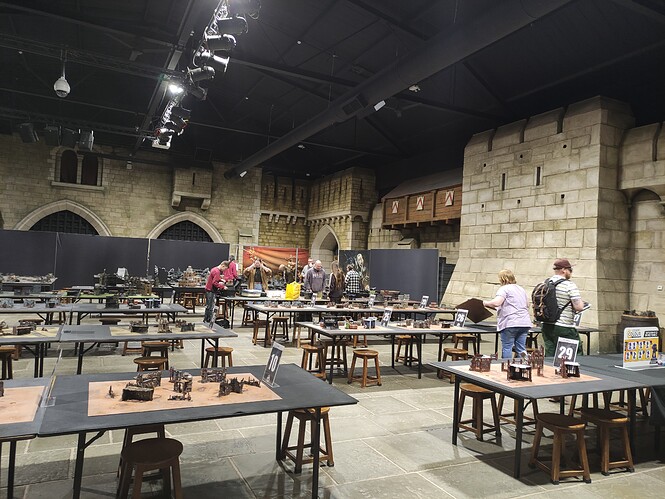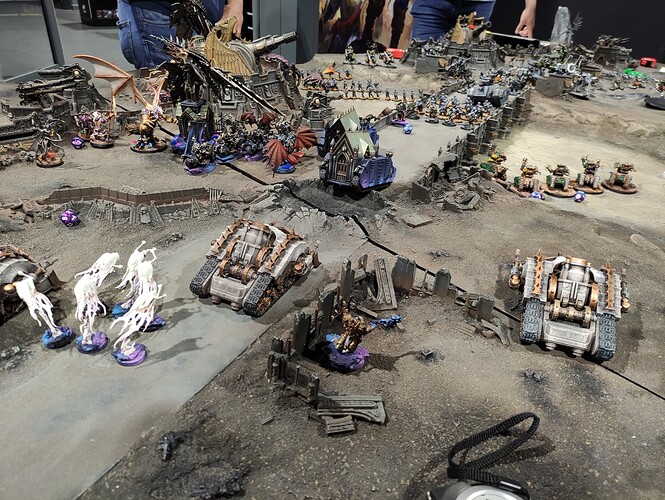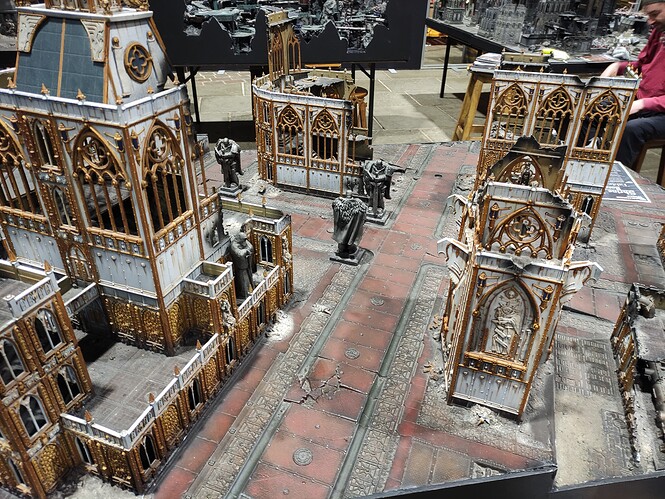I’ll check it out. Let me know if you ever want to beat up on a newbie. I’d prefer to take my lumps from someone here than randos at the game store.
Don’t be–I, at least, enjoy living somewhat vicariously via this stuff. Can you say some more about Kings of War? I’ve never heard of it.
Kings of War is a rank-and-file-style fantasy wargame which is superficially similar to old Warhammer Fantasy but is actually closer to something like Black Powder or Hail Caesar. It uses block formations of units, but there is no fiddly model-removal mechanics and the movement rules are heavily streamlined. Unlike modern Warhammer games were a lot of the strategy is related to list-building and combos, KoW is more about manuevering units efficiently, punching holes in the enemy line with strong units, and then exploiting them to gain powerful flank attacks. It feels more like you are actually using battlefield tactics instead of just countering the other player’s “deck”.
It is super easy to learn and teach, and you only really need to memorize a handful of special ability keywords to play most armies. It is also a relatively quick game, even large games played with many units (like Black Powder). We played an over-sized four-player game on New Year’s day and finished in about 2.5 hours.
Miniwargaming did a nice demo of a KoW game that I highly recommend watching if you’re interested. Their armies are about half the size of a standard 2000pt army.
Thanks!
Really quick other game I want to say a little about. My wife bought be Deadzone for Christmas and I’ve been playing a lot of that with her lately. It’s a fantastic small-scale sci-fi skirmish game, similar to 40K Kill Team. It is actually even more easy-to-play than KT and doesn’t even require ruler measurement. In fact, I really love how you measure distance in “cubes” (basically grid squares on a board) instead of inches but the actual models position within the square is important for LoS. The models are a mixed bag (toxic space rats - GREAT, generic soldiers — MEH), though I really like Mantic’s official terrain system which is modular and designed to fit in the board grid.
The game also has some clever mechanics that board gamers will appreciate, such as special command dice that you can roll (and reroll) each turn that give you extra actions. Also, exploding d8s!
Hey, sorry to necro this thread (I usually read the forums, but don’t post much), but I wanted to write up what I’ve been playing this my last post.
I’ve been getting into more Mantic games the past year. Deadzone is great, and my wife and I have been having fun with the recent official campaign rules. A few friends and I briefly go to into Kings of War, which quickly became one of my favorite wargaming rulesets. It is a perfect example of a very streamlined game that has plenty of depth without resorting to rules bloat (I’m looking at you 40K). I recently also bought the starter box for Firefight, which is their sci-fi game that is pretty much a combination of Deadzone and Kings of War. Only played one game so far, but I’m impressed with it.
The other big elephant in the room recently in miniature wargaming is the imminent release of new GW Horus Heresy rules and models. Having bought Firefight recently, I wasn’t planning on buying-in to this system as well, but it turns out that most of my gaming group is interested in this and not so interested in Firefight (sad face). Though I am not a fan of modern 40K, I am even less of a fan of 7th edition (which is what HH rules are based on). However, in retrospect most of my gripes are based on army rules from back then instead of the core mechanics (which I’ve been told have been tightened up as well).
Also, I know there has been much said about the price. However, $300 is actually not that much for what is like 80% of a full Warhammer army plus the big core rulebook, dice, and templates. That said, you can buy a full army and rulebook in Firefight for less than $200, so everything is relative (though Mantic miniatures are vastly inferior to GW).
Anyone else play any miniature wargames lately? Anyone else planning on getting into Horus Heresy?
I don’t have anything to add to the thread, but I enjoy reading it very much. Please keep posting!
My son got into WH40K recently, so I play that occasionally and mostly got involved in assembling and painting. I don’t have any qualified insights about whether it’s good, I’ve never played any wargames before, but I do have a nagging suspicion that it’s more about the dice roles and having the right units, rather than tactical acumen. It’s still fun though, albeit a little too long for me.
We went to Warhammer world last weekend for an event where my son played with other kids and it was a great day.
They had some amazing tables arranged (although those weren’t used in the event).
Yeah, I would agree with this. Warhammer 40K is sometimes compared to Magic:TG – they both have a strong emphasis on deck/army building. I’ve seen games of 40K that were pretty much decided on the first turn due to this. I have some friends who absolutely love this aspect of the game. Personally, I don’t have the time (or money!) to get this deep into the army building, so I’m not a huge fan.
As for dice rolling, at the end of the day pretty much all miniature wargames are beer-and-pretzel affairs. Though some people do play competitively (though they’re not fun to play against!), most people just want an excuse to move little plastic figures around and chuck a bunch of dice. That said, there are definitely plenty of tactical decisions to make, especially spatial ones. Even deciding where to deploy certain units at the beginning of the game is very important. However, in the end it is really about optimizing your probability of winning, and even if you do everything right there is still a chance the dice gods will smile upon your opponent instead of you.
As for the playtime issue, my experience is that most downtime in wargames is due to checking rules. This is especially true in games with heaps of special rules, like Warhammer 40k. I’ve found that it really helps to prepare cheatsheets for the armies I play and also print out any reference sheets that you can find on the internet for the game. Some newer rulesets, like Firefight, have mechanics that are designed to speed up play (like only measuring for leader units instead of each one individually).
Is there any miniatures ruleset that is free of… How to put this… “Tactical” randomness?
Like, let’s roll with the the Magic comparison for a second. In Magic, almost all cards are deterministic in that they do what they say they’ll do, with little wiggle room. My Lightning Bolt always does three damage. My Grizzly Bears is always a 2/2 when I play it. And so on. The randomness in Magic comes at a more strategic level - what deck did I bring in against my opponent’s deck, what cards did I draw in my opening hand, what cards do I draw each turn, etc. But I never play a counter spell and find that it missed, for example.
Does that exist in miniatures games at all?
Does Chess count? 😅
In all seriousness though, I’ve never played any wargames (miniature or otherwise) that don’t have any random elements in their combat resolution. Deterministic combat results would really hurt the organic, emergent narrative that attracts many players (myself included) to these types of games.
Actually, one of the benefits of throwing so many dice in Warhammer games is that you can more easily predict the distribution of dice results. Most competitive players use probability models to optimize their armies. Too Fat Lardies, the designers of Sharp Practice, have also stated that they incorporate a lot of dice rolls into their designs for this reason.
Ironically, it’s the rulesets with less dice rolling that feel much more “swingy”. However, these type of games are usually quicker and lighter overall, so it’s not so much of a problem.
Dreamblade might come close? Imagine chess with horror themed pieces that have a range of special abilities. The battlefield is area control and abilities make positioning and attacking highly tactical. Combat still invoves dice, but positioning and abilities mitigate randomness to make it much more deterministic.
Well out of print, though you can find lots secondhand. The minis are awesome in their theme and variation.
Is it really a minis game though? I guess it’s kind of a team-building tactical minis skirmish game.
I actually pulled out all my Dreamblade minis to give Reign in Hell a crack with the solo campaign expansion, since I think they would be perfectly suited to that theme as well.
While I’ve never been a miniature wargamer, I’ve always admired the setups. The pictures above are just cool.
This statement made me remember something that occurred years ago at Gencon. As I mentioned, I loved looking at the setups so I’d often walk though the mini wargaming area. One late night I had time and started watching a game I’m pretty sure was WH 40K. The board and terrain were fabulous, and the minis were numerous and very well painted.
I watched for a while and then started chatting with the team I was standing with. While I’ve never played this kind of game, I was in the military and have played alot of tactical (non-miniature) wargames. So I started asking about putting artillery fires on specific map chokepoints and ideas on where they could set up killzones with overlapping fires. They looked at me like I was speaking a different language (maybe I was). I realized as cpugeek13 describes they were having fun rolling dice and moving minis around. I decided to shuffle on to somewhere else.
The OG miniatures wargame Little Wars uses physics and the inherent inaccuracy of toy cannons as the randomizers, but requires a large collection of metal toy soldiers and antique toy artillery to play, along with a substantially larger playing surface than your average 40K game.
I’ve tried it with 3D-printed pieces, which leave something to be desired in that the soldiers are a bit too easy to knock over, but it does yield a lot more of the chokepoints and kill zones @eliandi mentions.
In 40k if you’re experiencing tactical randomness then you probably aren’t rolling enough dice with enough re-rolls… :)
This is a good example of the gap between sci-fi/fantasy wargamers and historical wargamers. Historical wargamers are often very concerned about the feasibility of using real-world, historic tactics in their games to create a more realistic (not necessarily simulation) narrative. Sci-fi/fantasy wargamers tend to be more interested in re-enacting Hollywood movie scenes with lots of heroes and superhumans. That’s not to say that some historical wargames aren’t a bit “Hollywood” as well (especially some WWII ones).
Unfortunately, sci-fi/fantasy wargames have grown a lot in the past 20-30 years and historicals have remained relatively stagnant (except for Bolt Action, which is kind of a cross-over hit). That said, I think historical wargame rulesets often have much more interesting mechanics since they can’t rely on special rules and combos as much.
One historical rule set that I’m really excited to try is Clash of Spears, which has an interesting exhaustion mechanic that affects unit behavior based on what actions they’ve taken and how heavy their equipment is.
Great reply. I did remember I was also into Advanced Squad Leader just before my Gencon WH 40k, so your comment on Hollywood vs realism was spot on.
Your post also made me read up on Bolt Action (the minis are way cool, but the game is probably not for me), but also remember the fun (and rules horror) of ASL
Happened upon this Twitter thread today; related, but not about minis, strictly speaking: https://twitter.com/DrCrossbows/status/1534882692969406464
The tldr is that (medieval) board wargames focus on battles (and the Decisive Battle) to the exclusion of sieges, logistics, and politics, which were generally much more important and relevant to the outcome of wars.
Haven’t played siege-focused wargame rules, though I know there are some out there. However, I suspect that storming a castle wouldn’t be as interesting tactically (kind of like sieges in Total War games). I have played around with the idea of writing my own rules for this and have even read some books about it.
As for logistics and politics (as well as other strategic aspects of warfare), I have played some historical games that highly abstract these, usually in the pre-game or setup phases. Mortem et Gloriam has a really interesting pre-game mini-game where you’re trying to maneuver the enemy army into advantageous terrain before the battle, which affects what terrain pieces you can place on the field. I have also seen games incorporate this into game scenarios or missions, such as having parts of the army arrive late due to logistical or weather issues. These kind of mechanics are also great for campaign-level meta-games, where there is a strategic phase between battles.
It’s true that pitched battles were not as common as sieges, especially during the Middle Ages, but from a tactical gameplay perspective, they are usually not as interesting to play. Something to remember about many pitched battles is that usually neither side would commit unless they thought they had a chance of winning, which often starts both armies on a relatively even footing. This helps with balancing the games and making them more fun to play. Sieges were often one-sided and either ended quickly (through storming or surrender) or lasted for months. Like I said above, I think storming a castle could be fun, but I think the actual tactical decision-space is a bit limited.
I have seen some broad generalizations about how battles were decided before they began based on logistics, but I don’t really necessarily buy that. Instead, I think scouting and quality of leadership (which are included in many historical wargames) probably had a much bigger impact in these battles. That said, you won’t find anyone denying that logistics (and politics) definitely had a huge effect on campaign strategy in wars.
Also, there are many historical wargames recently that focus on smaller skirmishes which were very common during wartime (and sometimes even in peacetime), but which do not get much attention in documented histories. The Clash of Spears rule set that I mentioned above is a great example of this kind of game. At this scale, logistics don’t really factor into the fighting at all.






